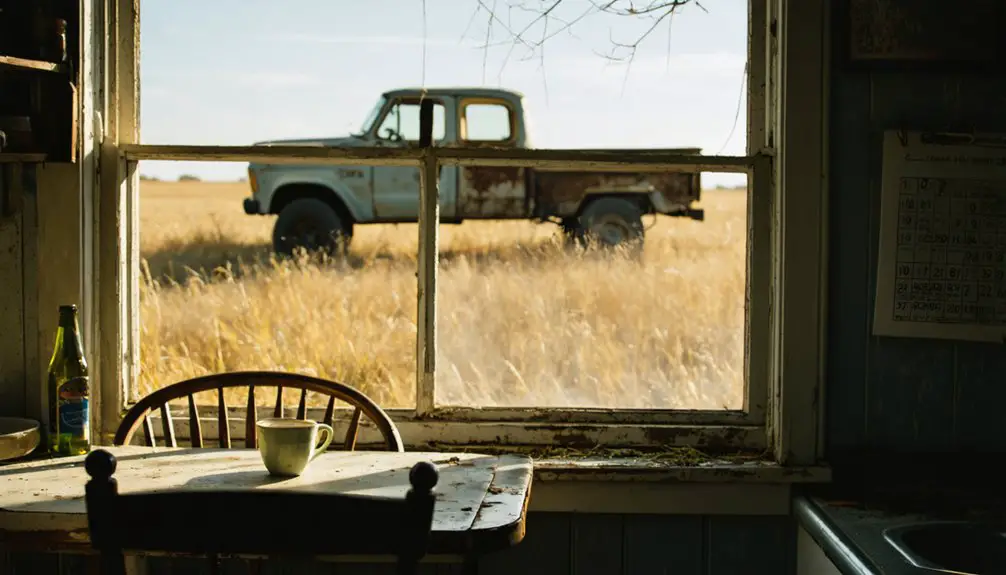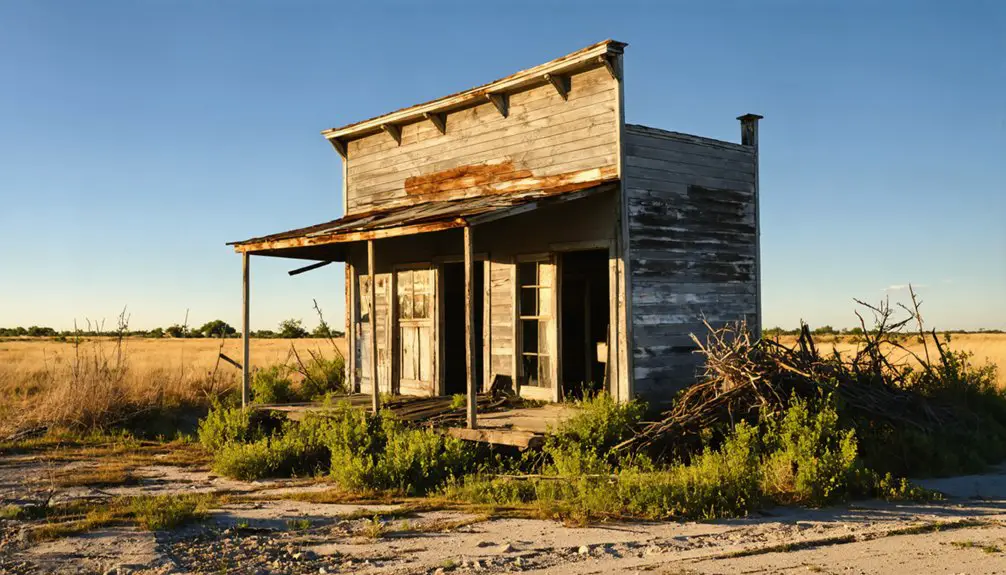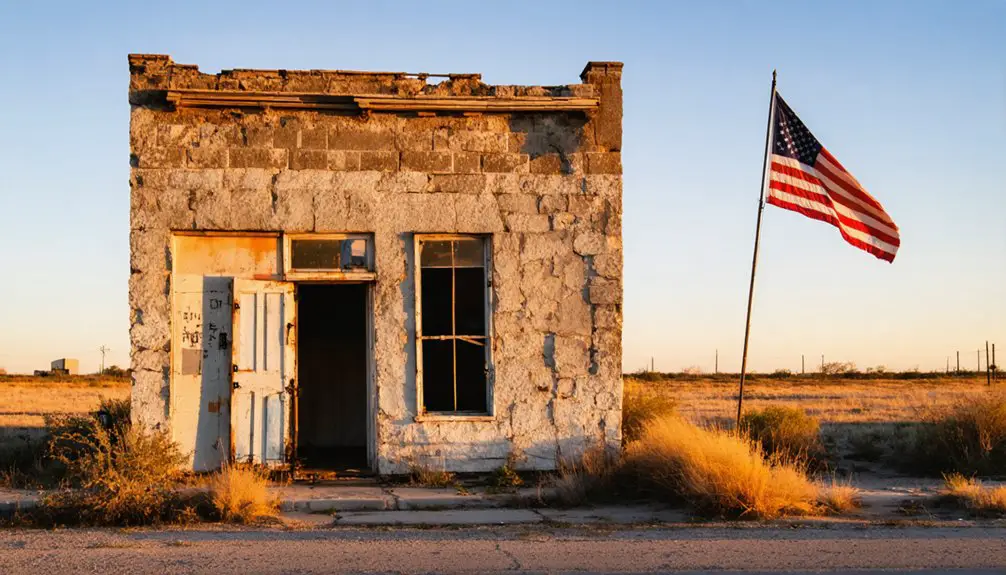You’ll find Bartonsite in McLennan County, Texas, where it began as a promising frontier settlement in the 1850s. The community thrived on cotton farming and cattle raising, with pioneer families building forts for protection along Alum Creek. When the Santa Fe Railway bypassed the town in 1907, Bartonsite’s dreams of becoming a transport hub vanished. The last residents departed in the early 2000s, leaving only foundations and historical markers to tell the tale of this prairie town’s rise and fall.
Key Takeaways
- Founded in the 1850s by Albert Barton and Ewell Everett, Bartonsite was established as a frontier settlement in McLennan County, Texas.
- The town’s decline began in 1907 when the Santa Fe Railway bypassed the community, crushing hopes for economic growth.
- Agricultural challenges and lack of rail transportation caused businesses to close and residents to relocate throughout the twentieth century.
- The last residents departed in the early 2000s, leaving Bartonsite completely abandoned and officially qualifying it as a ghost town.
- Today, only building foundations, cemetery plots, and historical markers remain as evidence of Bartonsite’s former existence.
The Birth of a Prairie Settlement
As pioneers pushed westward across Texas in the 1850s, the settlement of Bartonsite emerged when Albert Barton, Ewell Everett, and other founding families established homesteads on McLennan County’s western frontier. The settlers found themselves in a landscape where tall golden grasses stretched for miles, resembling an unharvested grain field. Like the early settlers of Alum Creek who established a fort for protection against Indians, the Bartonsite pioneers had to maintain constant vigilance. You’ll find their story intertwined with the rich blackland prairie, where they cultivated cotton and faced pioneer challenges including Native American threats and the need for mutual defense.
Railroad Dreams and Broken Promises
You’ll find that Bartonsite’s ambitious railroad station plans centered on the Santa Fe’s promised Panhandle Short Line extension from Plainview to Lubbock in 1907.
The town’s founders envisioned a bustling transport hub, complete with a depot and associated commercial services to serve the region’s ranching and farming interests. Much like the town of Kyle which established its success through I&GN Railroad operations in the 1880s, Bartonsite hoped to prosper through rail connections.
When the Santa Fe Railway ultimately bypassed Bartonsite, these dreams of becoming a crucial transportation center evaporated, leaving behind only unrealized plans and disappointed settlers. The Texas Midland Railroad had proven elsewhere that successful rail connections could transform local economies through improved freight and passenger service.
Failed Station Plans
Though Bartonsite seemed destined to become a thriving railroad hub in central Texas during the 1880s, a perfect storm of financial setbacks and political hurdles derailed those dreams. The failed ambitions of multiple rail companies, including the Galveston & Red River Railway and Texas Western Railway, left Bartonsite waiting for tracks that would never arrive.
Railroad financing proved especially challenging as:
- Land grant law repeals diminished potential profits
- Investor confidence crumbled amid regulatory changes
- Competing rail lines made new routes economically unfeasible
You can still trace the ghost of these abandoned plans in partial track segments near Bartonsite, where promoters like Paul Bremond once envisioned a bustling network of narrow-gauge railways connecting farming communities. The lack of capital that initially stalled the Galveston & Red River Railway project in 1848 foreshadowed similar financial difficulties that would plague later railroad development attempts in the region. The Texas Western Railway’s failed extension to Cat Springs in 1887 further dampened hopes for regional rail connectivity.
Instead, route changes and financial troubles pushed the major lines away, leaving Bartonsite’s station dreams permanently stalled.
Vanished Transport Hub
The planned Santa Fe Panhandle Short Line held Bartonsite’s destiny in 1907, when Joseph J. Barton envisioned his ranch property becoming a bustling rail hub.
You’ll find the town’s unrealized dreams reflected in its rapid descent into abandonment, as the promised railroad connection never materialized.
While neighboring towns like Abernathy flourished with their rail connections, Bartonsite’s lack of transportation infrastructure led to devastating economic isolation.
Without access to broader markets, agricultural producers couldn’t ship their goods efficiently, and businesses couldn’t receive regular supplies.
Like the failed excursion train venture that plagued other Texas rail lines, Bartonsite’s ambitious transportation plans never gained traction.
The Queen Anne-style house built by Barton in 1909 stood as a testament to his optimistic vision for the community’s future.
The town’s carefully laid plans crumbled as residents and merchants relocated to better-connected communities.
Today, only Barton’s house and historical markers remain to tell the tale of a settlement that staked everything on railroad promises that never came true.
Life in Early Bartonsite
During Bartonsite’s early settlement period in 1907, pioneer families carved out a hardscrabble existence on the southwestern Hale County frontier, drawn by the promise of fertile soil and fresh creek water.
You’d find community resilience reflected in their subsistence farming and agricultural innovation through the introduction of red winter wheat as an essential cash crop.
Life in early Bartonsite centered around three crucial elements:
- Self-sufficiency in farming, supplemented by cattle raising and timber harvesting
- Shared security responsibilities against Native American raids and frontier threats
- Cooperative community building, including a donated-land schoolhouse
Settlers embraced pioneer values while adapting to challenging frontier conditions.
Like the early settlers of Travis County, residents established a first schoolhouse to educate their children and strengthen community bonds.
They’d gather at community facilities and Queen Anne-style homes, forging strong bonds through mutual support and shared determination to tame the Texas wilderness. Two waterways, known as Loving and Sharps Branch, provided essential fresh water resources for the developing settlement.
When Commerce Faded Away
If you’d visited Bartonsite in the 1920s, you would’ve seen a bustling Main Street with merchants enthusiastically awaiting the promised railroad connection that never materialized.
The town’s hopes of becoming a major commercial hub evaporated when railroad companies chose alternate routes, leaving local businesses without essential transportation links to larger markets.
Railroad Dreams Vanished
While Bartonsite’s initial growth seemed promising in 1907, its fate hinged entirely on the anticipated Santa Fe railroad extension from Plainview to Lubbock that never materialized.
Joseph J. Barton’s railroad speculation drove the town’s planning, attracting 250 residents by 1909 who shared his vision of rail-connected prosperity.
The economic impact of the railroad’s failure proved devastating, as you’ll see through these key consequences:
- Businesses and families relocated to rail-served towns like Abernathy
- Agricultural producers lost access to efficient shipping and broader markets
- The post office closure in 1921 marked the community’s final decline
While neighboring towns with rail service flourished, Bartonsite faded into obscurity, becoming a stark reminder of how railroad decisions shaped Texas settlement patterns in the early 1900s.
Main Street Goes Silent
As the railroad dream crumbled in the early 1910s, Bartonsite’s once-bustling Main Street transformed from a commercial hub into a stark reminder of failed ambitions.
You’d have witnessed the gradual exodus of businesses that once served the community’s daily needs – grocery stores, banks, and specialty shops shuttering their doors one by one.
Economic challenges mounted as residents sought opportunities elsewhere, and the rise of big-box stores in nearby urban centers drew away what remained of local commerce.
The historic early 1900s buildings, though architecturally significant, fell into disrepair.
While you’ll still find traces of life, like converted Airbnb spaces in old bank buildings, Main Street’s vibrant past exists mainly in cultural memory.
The boarded windows and deteriorating facades tell the story of a commercial district that couldn’t survive without its promised railroad lifeline.
The Last Residents Depart

Through the latter half of the twentieth century, Bartonsite’s population steadily dwindled until its final residents departed in the early 2000s.
You’ll find the town’s final farewell played out as families relocated for better opportunities, leaving behind ghostly remnants of what was once a vibrant community.
The exodus happened in distinct waves:
- Major employers shuttered operations, forcing workers to seek jobs elsewhere.
- Essential services like schools and shops closed, making daily life unsustainable.
- The last handful of residents, mostly elderly caretakers, left when maintaining the declining infrastructure became impossible.
What Remains Today
Today’s visitors to Bartonsite will find little evidence of the once-thriving community that stood here. The few architectural remnants consist mainly of scattered building foundations and partial walls, now largely hidden beneath grass and shrubs.
Nature has reclaimed most of the original town site, transforming it into open pastureland.
Historical markers and cemetery plots serve as the primary indicators of Bartonsite’s existence, offering information about the town’s past for those who venture to explore.
You’ll find the land is now privately owned, typically part of larger ranching or farming operations, which can limit public access.
No permanent residents remain, and all utilities and infrastructure have long since been abandoned.
The ghost town stands as a quiet reflection of rural Texas decline.
Legacy in Hale County History

While many Texas ghost towns faded into obscurity, Bartonsite’s legacy endures as a prime example of railroad-driven speculation in early 20th century Hale County.
You’ll find Bartonsite’s story woven into the broader narrative of community resilience and agricultural transformation that shaped the region’s development.
Bartonsite’s legacy teaches three enduring lessons about frontier development:
Frontier development success hinged on three key factors: railroad investment, agricultural adaptation, and economic resilience.
- Railroad speculation could make or break communities, as shown by the $75,000 investment that transformed Hale County’s economy.
- Agricultural diversification followed transportation access, enabling farmers to shift from cattle to crops.
- Community survival depended on adapting to changing economic patterns, which Bartonsite ultimately failed to do.
Though Bartonsite didn’t survive, its brief existence helped catalyze Hale County’s evolution from isolated rangeland to thriving agricultural center.
Lessons From a Lost Community
Bartonsite’s disappearance offers valuable insights for modern rural communities facing similar challenges of economic sustainability. You’ll find that the town’s overdependence on agriculture and its failure to secure essential railroad connections ultimately sealed its fate, highlighting the critical need for economic diversification in rural planning.
When you examine Bartonsite’s story, you’ll see how community resilience depends on establishing multiple economic pillars and transportation options. The town’s swift decline after losing key services shows why you can’t rely on a single industry or infrastructure element.
Today’s rural communities must adapt by developing varied economic opportunities and maintaining strong connections to regional markets. Bartonsite’s legacy reminds you that survival requires forward-thinking planning and the flexibility to evolve with changing economic landscapes.
Frequently Asked Questions
Are There Any Paranormal or Ghost Stories Associated With Bartonsite?
Unlike 43% of Texas ghost towns that report paranormal activity, there aren’t any documented ghost sightings or haunted locations associated with Bartonsite. You’ll find its story centers on economic decline rather than supernatural events.
What Native American Tribes Originally Inhabited the Bartonsite Area?
You’ll find that three major Native American tribes historically dominated this area: the Tonkawa, Lipan Apache, and Comanche. The Tonkawa allied with Texas Rangers, while Comanche controlled vast territories through the 1700s.
Can Visitors Legally Explore the Remaining Structures at Bartonsite?
You can’t legally explore Bartonsite’s structures without explicit permission from property owners. Even though it’s abandoned, legal restrictions still apply, and exploration guidelines require authorization to avoid trespassing violations.
Were Any Movies or Television Shows Ever Filmed in Bartonsite?
While there’s no record of Bartonsite films or shows shot directly in the ghost town, you’ll find several productions like “1923” and “Fear the Walking Dead” filmed nearby in historic Bartlett instead.
What Valuable Artifacts Have Been Discovered at the Bartonsite Site?
You’ll find remarkable archaeological finds including prehistoric dart tips, atlatls, stone tools, 1820s coins, and historic artifacts that demonstrate the site’s historical significance spanning indigenous to pioneer periods.
References
- https://mix941kmxj.com/the-strange-sad-story-of-a-texas-ghost-town-youll-never-visit/
- https://www.tpr.org/economy-and-labor/2024-11-14/texas-uneven-population-boom-is-creating-ghost-towns-in-many-rural-counties
- https://www.youtube.com/watch?v=fP2EVY0_O2k
- https://mix941kmxj.com/see-how-two-texas-ghost-towns-battled-for-the-county-and-lost/
- https://en.wikipedia.org/wiki/List_of_ghost_towns_in_Texas
- https://www.texasescapes.com/TexasPanhandleTowns/Bartonsite-Texas.htm
- https://texashillcountry.com/5-haunting-texas-ghost-towns/
- https://www.texasescapes.com/TOWNS/Texas-Ghost-Towns-5-Texas-Panhandle.htm
- https://bartlettsecrets.com/2023/05/the-heart-and-soul-of-the-revitalized-ghost-town-of-bartlett-texas/
- https://digital.library.txst.edu/bitstreams/692019f0-5297-4848-80bb-a3792824ab67/download



